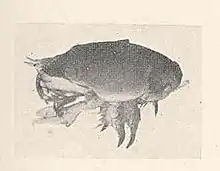Emerita talpoida
Emerita talpoida, known generally as the Atlantic mole crab or Atlantic sand crab, is a species of mole crab in the family Hippidae. It is found in the western Atlantic Ocean and Mexico along the shoreline.[1][2][3]
_(14598329499).jpg.webp)
| Emerita talpoida | |
|---|---|
 | |
| Scientific classification | |
| Kingdom: | Animalia |
| Phylum: | Arthropoda |
| Subphylum: | Crustacea |
| Class: | Malacostraca |
| Order: | Decapoda |
| Suborder: | Pleocyemata |
| Infraorder: | Anomura |
| Family: | Hippidae |
| Genus: | Emerita |
| Species: | E. talpoida |
| Binomial name | |
| Emerita talpoida (Say, 1817) | |
| Synonyms[1] | |
| |
Range
The Atlantic mole crab inhabits the swash zone of sandy beaches from Cape Cod south to the gulf Coast of Mexico.[4][2] It is one of six New World Emerita species.[5]
Ecology
Like all of the nine Emerita species, the Atlantic mole crab is a fossorial filter feeder. It requires moving water in order to feed, and it does so by burrowing itself backwards into the sand.[6] It uses its exposed feathery antennae to filter algae, detritus, and plankton.[7][8]
The Atlantic mole crab is an important food source for the Atlantic ghost crab, the blue crab, and certain species of fish in the swash zone.[9][8] Shorebirds, notably sanderlings have also been observed foraging for sand crabs.[10] The combination of the its burrowing feeding strategy and its camouflaged carapace assist the Atlantic mole crab in evading predation.[8]
Because they spend much of their life in the swash zone, they can serve as a bioindicator for the effects of large-scale engineering works.[6]
Taxonomy
Emerita talpoida was oiginally recorded as Hippa talpoida in 1817.[11] In 1879 a review of the family reassigned multiple species, including talpoida, from the genus Hippa to the genus Emerita.[5] The two are now considered sister genera.[5]
References
- "Emerita talpoida Report". Integrated Taxonomic Information System. Retrieved 2019-09-25.
- "Emerita talpoida". GBIF. Retrieved 2019-09-25.
- "Emerita talpoida species Information". BugGuide.net. Retrieved 2019-09-25.
- "Atlantic Sand Crab Observations". inaturalist.org. Retrieved 2022-06-16.
- Haye, Tam, Kornfield, P. A., Y. K., Irv (2002). "Molecular Phylogenetics of Mole Crabs (Hippidae: Emerita)". Journal of Crustacean Biology. 22 (4).
{{cite journal}}: CS1 maint: multiple names: authors list (link) - Bowman, Dolan, Michael Lowell, Robert (1985). "The Relationship of Emerita talpoida to Beach Characteristics". Journal of Coastal Research. 1 (2): 151–163.
- Kenneth Henry Mann (2000). "Sandy beaches". Ecology of Coastal Waters, with Implications for Management. Volume 8 of Studies in Ecology (2nd ed.). Wiley-Blackwell. pp. 218–236. ISBN 978-0-86542-550-7.
- Christi, Mailing Address: P. O. Box 181300 Corpus; Isl, TX 78480 Phone: 361 949-8068 This is the primary phone number for the Malaquite Visitor Center at Padre; Us, National Seashore Contact. "Atlantic Sand Crab - Padre Island National Seashore (U.S. National Park Service)". www.nps.gov. Retrieved 2022-12-04.
- Tewfik, Alexander; Bell, Susan S.; McCann, Kevin S.; Morrow, Kristina (2016). "Predator Diet and Trophic Position Modified with Altered Habitat Morphology". PLOS ONE. 11 (1): e0147759. doi:10.1371/journal.pone.0147759. PMC 4732677. PMID 26824766.
- Peterson, Charles H.; Bishop, Melanie J.; Johnson, Galen A.; D'Anna, Linda M.; Manning, Lisa M. (2006). "Exploiting beach filling as an unaffordable experiment: Benthic intertidal impacts propagating upwards to shorebirds". Journal of Experimental Marine Biology and Ecology. 338 (2): 205–221. doi:10.1016/j.jembe.2006.06.021.
- Academy of Natural Sciences of Philadelphia.; Philadelphia, Academy of Natural Sciences of (1817). Journal of the Academy of Natural Sciences of Philadelphia. Vol. 1. Philadelphia: Academy of Natural Sciences of Philadelphia.
Further reading
- Nizinski, Martha S. (2003). "Annotated checklist of decapod crustaceans of Atlantic coastal and continental shelf waters of the United States" (PDF). Proceedings of the Biological Society of Washington. 116 (1): 96–157. ISSN 0006-324X.